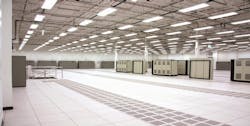In this this edition of “Voices of the Industry,” Robert McClary, Chief Operating Officer at FORTRUST, explains the Uptime Institute’s Tier Rating System and the requirements for achieving gold certification.
Robert McClary, FORTRUST
The Uptime Institute’s Tier Rating System has been the standard in the data center industry for years. Despite undergoing several changes and updates, this tier rating system is used by many data center service providers to differentiate themselves in the marketplace,and also helps customers select a data center operator that can meet their needs.
While the Uptime Institute is a credible and recognized source, there are a few details and nuances of the tier system that can be a challenge for decision-makers to understand. For instance, before achieving a Tier Certification for Operational Sustainability, operators must obtain a Certification of Constructed Facility, and that can only take place after a Certification of Design Documents. This is one example of the many certification steps that a data center or provider must go through.
On top of this, each tier within the Operational Sustainability Certification has different levels within itself, including gold, silver and bronze. But what makes a Tier III Certification of Constructed Facility provider different from a Tier III Gold Certification of Operational Sustainability colocation data center? Today, we’ll break down the Operational Sustainability Certification, and explain the Gold-level certification.
The Path to Operational Sustainability
The tier system was developed by The Uptime Institute for classifying different levels of data center reliability, and has become central to discussions of how to plan and design enterprise data centers. Uptime refers to it as the “de facto industry standard for predicting site reliability.” The standards identify four tiers that classify data centers based on their reliability, based upon designs and infrastructure (see the Uptime web site for a detailed explanation).
A data center operator cannot receive an Operational Sustainability Certification from Uptime Institute until it receives the Tier Certification of Design Documents and then the Tier Certification of Constructed Facility from Uptime Institute. From here, service providers can seek their Operational Sustainability rating, which is awarded according to four separate tier classifications.
The first phase on this path, Certification of Design Documents, requires operators to submit design documents that outline their facility’s mechanical, electrical and structural design, among other elements, at the site. Uptime Institute then reviews these according to the standards detailed in its Tier Standard: Topology and assigns a tier rating.
Once awarded the Certification of Design Documents, data center service providers can seek a tier certification using the Constructed Facility Certification. This award verifies that the facility has been constructed according to the design documents, and that it is performance tested and able to support the level of service and availability required according to the standards of Uptime’s Tier Standard: Topology. But what does all this mean for customers?
“The Tier Classification System is the recognized global standard for data center reliability and performance,” Uptime Institute explained. “Achieving Tier Certification of Operational Sustainability verifies that practices and procedures are in place to avoid preventable errors, maintain IT functionality, and support effective site operation. The Certification process ensures operations are in alignment with your organization’s business objectives, available expectations and mission imperatives.”
Operational Sustainability: The Gold Standard
After achieving these prerequisite certifications, data center operators can work towards an Operational Sustainability certification. Here, data center facility, processes, practices and the behaviors to support overall availability are examined according to benchmarks for Management and Operations, Building Characteristics and Site Location.
However, the different levels and certifications don’t end here. Besides being awarded the Certification for Operational Sustainability according to the four tiers in Uptime Institute’s rating system, there are also Bronze, Silver and Gold certifications within each tier. In this way, a data center provider could receive a Tier II Silver Operational Sustainability, a Tier III Bronze Operational Sustainability, and so on. Data Center Knowledge contributor Rich Miller explained that the gold, silver and bronze levels come in addition to the tier levels.
“Uptime says Tier Standard: Operational Sustainability will provide a means to rate how effectively each data center is managed and operated based on each Tier’s criteria,” Miller wrote. “These Gold, Silver or Bronze ratings are designed to complement the Tiers.”
Download the FORTRUST white paper on How to Select a Collocation Provider.
Each of those levels breaks down as follows:
- Bronze signifies that while the facility operator did achieve the certification, there are considerable opportunities for improvement within their operations and building in order to leverage the full potential of the current infrastructure.
- Silver denotes that while the installed infrastructure is closer to realizing its full potential, opportunities for improvement still exist.
- A Gold certification shows that the provider manages and operates its facility to the fullest potential that the installed infrastructure will provide. Sometimes, this potential is even exceeded thanks to the facility operator’s industry-leading procedures and processes.
The FORTRUST Denver data center has been awarded a Tier III Gold Certification of Operational Sustainability, meaning it operates according to the Tier III level of the Uptime Institute’s Tier Standard: Topology. The Denver data center has redundancy in place for all critical systems, and is concurrently maintainable – service is never unavailable due to planned maintenance. FORTRUST has earned the Gold level of our Tier III Certification of Operational Sustainability. To find out more, contact FORTRUST for a tour of its Denver data center.



